I'm working to elicit a probability distribution from the Survey of Private Dealers, a ~monthly survey concerning the future direction of certain financial random variables. Latest example here.
There are two tables regarding a single random variable (future Federal Funds rate targets) that I'd like to turn into a prior probability of that random variable.
- "Provide your estimate of the most likely outcome (i.e., the mode) for the target federal funds rate or range, as applicable, immediately following the FOMC meetings and at the end of each of the following quarters and years below. For the time periods at which you expect a target range, please indicate the midpoint of that range in providing your response."
| Statistic | Modal Estimate |
|---|---|
| 25th percentile | 0.63% |
| Median | 0.63% |
| 75th percentile | 1.13% |
| # of respondents - 24 |
In other words, 24 respondents give 1 modal estimate, and 3 summary statistics are provided from those 24 data points.
- "Please indicate the percent chance that you attach to the target federal funds rate or range falling in each of the following ranges at the end of 2023."
| Bucket | Average Probability |
|---|---|
| < 0.00% | 1% |
| 0.00 - 0.25% | 15% |
| 0.26 - 0.50% | 17% |
| 0.51 - 0.75% | 24% |
| 0.76 - 1.00% | 17% |
| 1.01 - 1.25% | 13% |
| 1.26 - 1.50% | 7% |
| 1.51 - 1.75% | 3% |
| 1.76 - 2.00% | 2% |
| ≥ 2.01% | 2% |
| # of respondents - 21 |
In other words, 21 respondents gave a probability distribution of the same random variable, and the distributions were averaged.
Question: What is the right way for me to combine these two tables into a prior? The mode is easy in this case (clearly the 0.63% from the first table and the 0.51%-0.75% in the second table tell the same story), but unsure of how it would work in the general case.
